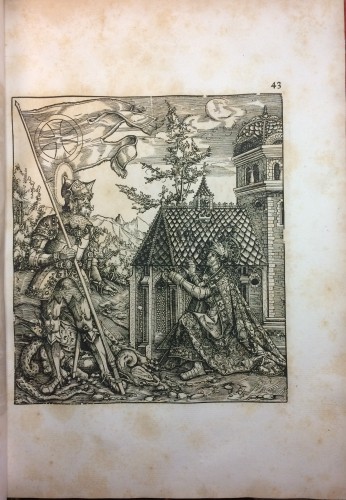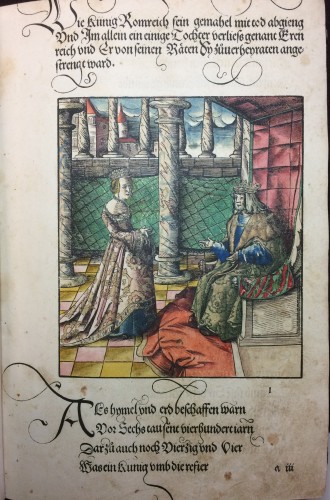This 1799 edition of Images de Saints et Saintes issus de la famille de l’empereur Maximilien I (The Images of Saints from the family of the Emperor Maximiliam I) contains for the very first time an almost complete series of the woodcuts that were originally commissioned by Maximilian I (1459-1519) to illustrate the legends, history and genealogy of earlier saints claimed to be connected to the House of Habsburg.

Woodcut depicting Saint Fridolin from Saints et Saintes issus de la famille de l’empereur Maximilien I (Vienna: F. X. Stöckl, 1799)

Woodcut depicting Saint Gudula holding a girdle book from Saints et Saintes issus de la famille de l’empereur Maximilien I (Vienna: F. X. Stöckl, 1799)
These illustrations were part of a broader historical project to compose a full chronicle of Maximilian’s ancestry. Unfortunately, the venture did not materialize as planned. With the death of the Emperor in 1519, interest in the project gradually faded away. However, the author of the narrative on which the illustrations of saints was based, Jacob Mennel (ca. 1470-1526), managed to publish his contribution in a pamphlet-like book: Seel unnd heiligen buch keiser Maximilians altfordern (Freyburg im Breyssgaw: J. Wörlin, 1522). Regarding the publication of the woodcuts, for which at least 122 woodblocks were produced, there were two early limited editions published in the sixteenth century. But for some odd reason unknown to us, each of them only contained 89 woodcuts.*
The editor of this comprehensive 1799 edition, Adam Bartch, found the original sixteenth-century set of 122 woodblocks in the Kaiserliche Hofbibliothek (Imperial Court Library) at Vienna, now the Österreichische Nationalbibliothek (Austrian National Library). As Bartch explains in the introduction, for his edition he could only print 119 woodcuts because three of the woodblocks were damaged.

Woodcut depicting Saint Modoald from Saints et Saintes issus de la famille de l’empereur Maximilien I (Vienna: F. X. Stöckl, 1799)
The existence of these woodblocks reveals evidence about the planned production of these images. Many of the blocks bear the names of the woodcutters and the dates when they presented their work, ranging from 3 November 1516 to 7 September 1518. These cutters were part of a group of artists working at Augsburg at the service of the Emperor under the direction of Jost de Negker. Nevertheless, there is no explicit evidence about who actually designed the illustrations. While Bartch attributed the woodcuts to Hans Burgmair (1473-1531)—as indicated in the title of his edition—scholars are now convinced that, by comparison with other examples of his signed work, these images of saints were created by Leonhard Beck (d. 1542), with the exception of woodcut no. 43 depicting Saint George, which was created by Hans Springinklee—note the HSK monogram on the right lower corner.

Woodcut depicting Saint George from Saints et Saintes issus de la famille de l’empereur Maximilien I (Vienna: F. X. Stöckl, 1799)
A former pupil of Hans Holbein the Elder (ca. 1465-1524), Leonhard Beck designed the illustrations for various works on behalf of the self-propagandisctic program of Maximilian I. For instance, this edition of The Images of Saints perfectly complements our copy of another panegyrical work, the Teuerdank, which was mostly illustrated by Beck. Published in 1517, the Teuerdank (noble thought) is a richly illustrated allegorical poem containing a fictionalized account of the adventures of Maximilian when traveling through the Nerthelands in 1477 to claim his bride, Mary of Burgundy.

Opening woodcut from Die geverlicheiten und einsteils der Geschichten des loblichen streitbaren und hochberühmten Helds und Ritters Herr Teuerdank (Nuremberg: Johann Schönsperger, 1517)
* A comprehensive examination of these illustrations can be found in the following article: Simon Laschitzer. “Die Heiligen aus der ‘Sipp-, Mag- und Schwägerschaft’ des Kaiser Maximilian I.” Jahrbuch der Kunsthistorischen Sammlungen des Allerhöchsten Kaiserhauses. 4 (1886): 70-288. For a summary of Laschitzer’s study see Campbell Dodgson. Catalogue of Early German and Flemish Woodcuts preserved in the Department of prints and Drawings in the British Museum. 2 vols. Quarto Press & British Publications Ltd., 1980: vol. 2, 126, 131-137.